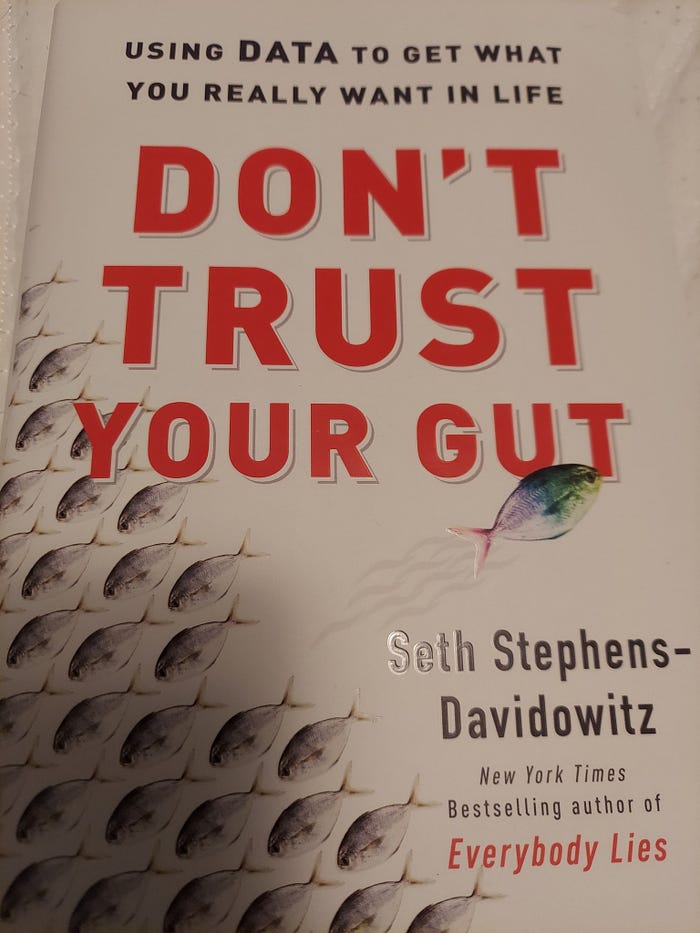Book Review — Don’t Trust Your Gut by Seth Stephens-Davidowitz

Yesterday evening, I finished Don’t Trust Your Gut: Using Data to Get What You Really Want in Life by Seth Stephens-Davidowitz. Seth is a former data scientist at Google and a former visiting lecturer at the Wharton School of the University of Pennsylvania.
Trusting our guts has been proven to be misleading. We are full of biases sometimes edged on by the media. The media lies to us — or at least gives us a misleading impression of how the world works by only selecting certain stories to tell us. Using data to cut through those lies can lead to information that helps make decisions.
Building on his first book, Everybody Lies, which became a New York Times bestseller and was named a book of the year by the Economist, Seth set out to leave the generic and focus on the use of data for the individual. Like a professional data scientist would, Seth digs into volumes of data and provides insights on romance, parenting, athletic success, wealth, luck, appearance, and happiness.
For instance, he discovers that there is no single predictor of marital success. Not religion. Not height. Not skin colour. Not wealth. Certainly not beauty. But that has not stopped us from preferring these qualities in our choice of mates. These factors drive desirability. Everyone chooses mates based on these criteria.
A good example is Height. While it is certainly no predictor of marital success, research shows that a 6-foot man earning $62,500 per year is, on average, as desirable as a similar 5′6″ man who earns $237,500. In other words, those six inches of height are worth about $175,000 in salary in the dating market. Generally, taller women had less success on the dating site. A woman who is 6′3″ tall, the researchers found, could expect to receive 42 per cent fewer messages than a 5′5″ woman. I know what you are thinking, but I won’t say.
Same thing with skin colour. To be desirable in the American market, an Asian man would have to earn a staggering $247,000 more in annual income to be as attractive to the average white woman as he would if he were white.
On the other hand, he finds out that when we go out with those not considered attractive in the conventional sense (in terms of height, wealth, race, etc), physical attraction can grow over time if we like a person (or disappear over time if we don’t like a person). So what does he suggest based on his data: That you go on more dates with undervalued assets (those who might not have the qualities that so many people find so alluring) even if we don’t initially find them attractive — and be patient, allowing a potential attraction to grow. There is a lot cramped into the research that you need to read this part.
On the subject of parenting, it turns out that many of the things that parents worry about most turn out to have surprisingly little effects on their kids. It turns out that on the weight of them, a standard deviation increase for activities like breastfeeding, chess, television, etc in the lives of kids is not mindblowing in the long term. Since 2011, the evidence has continued to accumulate that the overall effects of everything a parent does are smaller than most expect and that most of the decisions parents worry about don’t have a measurable impact on how a kid turns out. But he reveals something that matters greatly in how a kid turns out. Putting together the different numbers, more than 25% of the overall effects of a parent are driven by where that parent raises their child. In other words, one of the thousands of difficult decisions a parent must make has much more impact than others.
And for such an important decision, it hasn’t featured much in parenting self-help books. In the book The Parent Trap, Nate Hilger has pointed out that, among sixty top parenting books, not one advises parents on where they should raise their kids. That’s off. For those who live in the United States, he reveals a website that allows anyone to find out how advantageous any neighbourhood is expected to be for kids of different income levels, genders, and races. You would need to read the book to see the website.
I was surprised to see that a high school female rower had nearly a thirty-fold higher chance of getting a college scholarship than a high school female cross-country runner in America. Seth was as well. He wrote a brilliant chapter on setting up your kid for athletic success or at least having an edge via data in doing that.
Just like you may have guessed, in a properly-run society, you have the best chance of being in the top 1% of the wealthiest by owning a business. But there is so much in the data that many people do not know. Wading through tons of data, Seth learned that the typical rich American is not a tech tycoon, corporate bigwig, or some of the other people you might naturally have expected. In addition, all businesses are not created equally. Some of the most lucrative-sounding businesses have the shortest lifespan. Do you know the average lifespan of a clothing store? 3.75 years. Record store? 2.5 years. Data tells us that there are many fields in which tens of thousands of people start businesses, but few enter the top 1 per cent, let alone the top 0.1 per cent of earners.
Yet, as revealed in the book, whatever field you are in, certain career decisions make you more likely to be among the entrepreneurial successes in that field. A very good formula is: Spend many years building expertise and a network while proving your success in a field before striking out on your own in middle age. This necessarily means that the media narrative of likely young business success is a myth. Older people don’t just start businesses more than many of us realize; they also succeed at creating highly profitable businesses more often than their younger peers do. From the age of 42, older founders consistently had higher probabilities of success, at least until the age of sixty.
#WILT A 60-year-old start-up founder has a roughly three times higher chance of creating a valuable business than a 30-year-old start-up founder.
A couple of other myths were busted in the chapter such as the most successful employees founding the most successful firms. So I leave you to read the rest.
You would love the chapter about luck. And about Mona Lisa Effect. And the Da Vinci effect. And Picasso’s Rule.
I like the chapter about appearance the least. While insightful, I consider is laced with selective bias.
Perhaps it’s the chapter about happiness that he devotes his time the most to. It is a lengthy chapter about what influences our happiness. The Mappiness data provides us with clear insights about activities that yield much happiness and those that lead to less happiness than people expect. Can you guess the single activity that gives us the most happiness per time than any other across geography? If you guessed that you are right.
What about activities that give us less happiness and even reduce our happiness? Work is one of them. Work generally sucks, that’s obvious. Counterintuitively though, watching your favourite team also sucks. In fact, for you to get more pleasure than pain from supporting a team, it needs to win at least 67% of all its matches. When I looked up the Premier League table, only Man City has managed that since 2017. If you add other matches in the FA Cup, Carling Cup and Champions League, you would be hard pressed to see any club scale through over the last 3 seasons. So what’s the trick to being a happy sports lover? Don’t be attached to any team and watch more games by neutral teams. I know you are protesting already. Welcome to a life of misery.
Sports aside, you will get many other insights on activities to engage in to up your happiness level. Newsflash: social media is not one of them. Social media makes you miserable. Gardening is tremendous for your happiness. It’s a lovely chapter.
Data clears away the noise. That is what this book attempts and on my own, succeeds in. If you want data-driven answers to some of life’s biggest problems, then Don’t Trust Your Gut is for you. I wish it covered other areas of life such as friendship, work as a topic, and immigration.
A common criticism of the book I have seen online is that the book fails by being uni-dimensional in some chapters. In dating, for instance, he encourages not caring about looks for a successful marriage. Some say that certain people don’t care too much about themselves in this respect. They are optimizing for the genetics of their offspring in terms of intelligence, athleticism and even skin colour. Their goal isn’t a successful marriage but successful offspring. But that’s criticizing what Seth did not argue. Seth isn’t arguing for successful offspring. He is interrogating what makes successful marriages. There is another chapter on what makes children successful.
Seth raised the bar for the quality of insights. The tips are immediately practical and, if you are like me, makes you dig for more for your specific non-American circumstances. I can imagine it’d be on the list of books to read when the List of 2022 comes out by the usual suspects.
